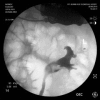Laparoscopic nephroureterectomy in a patient with a left ventricular assist device
- PMID: 24409214
- PMCID: PMC3886203
- DOI: 10.5489/cuaj.400
Laparoscopic nephroureterectomy in a patient with a left ventricular assist device
Abstract
Left ventricular assist device (LVAD) therapy is an established treatment option for select patients with advanced heart failure. Advances in technology and patient management have resulted in improved post-implant outcomes. Consequently, more patients with LVADs are presenting for evaluation and care of non-cardiac surgical disease. However, there is a paucity of literature regarding the optimal perioperative and surgical management of such patients. We present the case of a 71-year-old male with a HeartMate II (Thoratec Corporation, Pleasanton, CA) LVAD, who underwent a laparoscopic left nephroureterectomy for an upper urinary tract transitional cell carcinoma. His perioperative course was uneventful due to the multidisciplinary efforts of cardiac surgery, cardiac anesthesia, nephrology and urology. To our knowledge, this is the first reported case of a laparoscopic nephroureterectomy in a patient with a HeartMate II LVAD.
Figures



References
-
- Miller LW, Pagani FD, Russell SD, et al. Use of a continuous-flow device in patients awaiting heart transplantation. N Engl J Med. 2007;357:885–96. - PubMed
-
- Slaughter MS, Rogers JG, Milano CA, et al. Advanced heart failure treated with continuous-flow left ventricular assist device. N Engl J Med. 2009;361:2241–51. - PubMed
-
- Aaronson KD, Slaughter MS, Miller LW, et al. Use of an intrapericardial, continuous-flow, centrifugal pump in patients awaiting heart transplantation. Circulation. 2012;125:3191–200. - PubMed
LinkOut - more resources
Full Text Sources
Other Literature Sources
